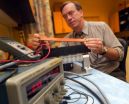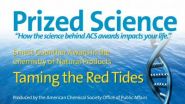Allergies and wheezing illnesses in childhood may be determined in the womb
A child's chances of developing allergies or wheezing is related to how he or she grew at vital stages in the womb, according to scientists from the University of Southampton
2010-10-26
(Press-News.org) A child's chances of developing allergies or wheezing is related to how he or she grew at vital stages in the womb, according to scientists from the University of Southampton.
The new research, funded by the Medical Research Council (MRC) and the British Lung Foundation, and undertaken at Southampton General Hospital, reveals that fetuses which develop quickly in early pregnancy but falter later in pregnancy are likely to go on to develop allergies and asthma as children. Scientists believe this is due to changes in the development of their immune system and lungs.
A fetus that grows too slowly in the womb is also more likely to become an infant who wheezes with common colds, possibly as a result of narrower airways in its lungs.
"Childhood allergies and asthma have become an epidemic in developed countries over the last 50 years. This research shows that in order to combat this, we need to understand more about how babies develop in the womb," comments Keith Godfrey, Professor of Epidemiology and Human Development at the University of Southampton and Deputy Director of the NIHR Nutrition Biomedical Research Unit at Southampton General Hospital.
"We already know that a baby's growth in the womb has an important influence on susceptibility to obesity and heart disease in later life, but this research provides some of the most direct evidence yet that changes in how the baby's immune system and lungs develops before birth can predispose them to some of the commonest childhood illnesses."
For the research, published in the Journal Thorax, University of Southampton scientists at the MRC Lifecourse Epidemiology Unit based at Southampton General Hospital studied more than 1,500 three year-old children who were taking part in the Southampton Women's Survey, the UK's largest study of women and their offspring. The Survey has studied how a woman's diet and lifestyle before and during pregnancy affects their baby's growth in the womb, and is monitoring how these early life influences determine health and development during childhood.
The team discovered evidence of sensitivity to common allergens (atopy) in 27 per cent of children who had developed quickly in early pregnancy but faltered later in pregnancy, as compared with 4 per cent in those with a slow early growth trajectory and quicker growth in late pregnancy.
Professor Stephen Holgate, from the Medical Research Council, says: "Unravelling the complex interplay between immunity and disease, over the course of a person's life, including before they are even born, is a core part of the MRC's research strategy. Furthering our understanding of the body's natural resilience is critical to developing new advances in the treatment of infectious diseases, autoimmune diseases and allergies."
Ian Jarrold, Research Manager at the British Lung Foundation, adds: "Children's lung health can be complex so this research, funded by the British Lung Foundation, is a considerable step forward in understanding why some children are more likely to develop allergies and asthma.
"The most commonly reported long-term illnesses in children and babies are conditions of the respiratory system. Increasing our understanding of childhood lung conditions is vital for developing new ways of diagnosing and treating lung diseases earlier in life."
INFORMATION: END
ELSE PRESS RELEASES FROM THIS DATE:
2010-10-26
The field that these researchers are working in is known by its nickname, "anti-spoofing", and basically consists in trying to detect all of the possible attempts at fraud that a biometric system might suffer, especially with regard to an action in which the user presents the biometric proof to the system. "What we are trying to do is detect those attempts so that the system can then act accordingly", explains the head of UC3M's Grupo Universitario de Tecnologías de Identificación (GUTI)(University Identification Technology Group), Raúl Sánchez Reíllo, who is leading this ...
2010-10-26
Flamingos apply natural make-up to their feathers to stand out and attract mates, according to a new study by Juan Amat, from the Estación Biológica de Doňana in Seville, Spain, and colleagues. Their research is the first to demonstrate that birds transfer the color pigments (carotenoids) from the secretions of their uropygial gland for cosmetic reasons. The uropygial or preen gland is found in the majority of birds and is situated near the base of the tail. The study is published online in Behavioral Ecology and Sociobiology, a Springer journal.
There is evidence ...
2010-10-26
AUGUSTA, Ga. - A daily dose of whole body vibration may help reduce the usual bone density loss that occurs with age, Medical College of Georgia researchers report.
Twelve weeks of daily, 30-minute sessions in 18-month old male mice – which equate to 55- to 65-year-old humans – appear to forestall the expected annual loss that can result in fractures, disability and death. Dr. Karl H. Wenger, biomedical engineer in the MCG Schools of Graduate Studies and Medicine, reported the findings with his colleagues in the journal Bone.
Researchers found vibration improved density ...
2010-10-26
A popular cancer drug could be produced cheaply and sustainably using stem cells derived from trees, a study suggests.
Researchers have isolated and grown stem cells from a yew tree whose bark is a natural source of the anticancer compound paclitaxel. The development could enable the compound to be produced on a commercial scale at low cost, with no harmful by-products.
Scientists and engineers behind the development say the drug treatment – currently used on lung, ovarian, breast, head and neck cancer – could become cheaper and more widely available.
The study was ...
2010-10-26
Patients with cancer found at the end of the large intestine called the rectum who receive one week of radiation therapy before surgery have a 50 percent reduction in chance that their cancer will return after 10 years, according to a large, randomized study presented at the plenary session, November 1, 2010, at the 52nd Annual Meeting of the American Society for Radiation Oncology (ASTRO).
"We believe that this short course of radiation will open a new window of opportunities in the treatment of rectal cancer," Corrie Marijnen M.D., lead author of the study and a radiation ...
2010-10-26
Men with prostate cancer who take anticoagulants like aspirin in addition to radiation therapy or surgery may be able to cut their risk of dying of the disease by more than half, according to a large study presented on November 3, 2010, at the 52nd Annual Meeting of the American Society for Radiation Oncology (ASTRO) in San Diego. The study involved more than 5,000 men with localized cancer whose disease had not spread beyond the prostate gland.
"Evidence has shown that anticoagulants may interfere with cancer growth and spread," Kevin Choe, M.D., Ph.D., lead author of ...
2010-10-26
Men treated for prostate cancer who were diagnosed after the start of routine screening had a significantly reduced risk of the disease spreading to other parts of the body (metastases) within 10 years of treatment, compared to men who were treated prior to the use of routine screening, according to the first study-of-its-kind presented November 1, 2010, at the 52nd Annual Meeting of the American Society for Radiation Oncology (ASTRO).
In 1993, routine prostate cancer screening became widely implemented through the use of a prostate specific antigen (PSA) test that was ...
2010-10-26
Prostate cancer patients who are treated with a combination of hormone therapy and radiation have a substantially improved chance of survival compared to patients who do not receive radiation, according to interim results of the largest randomized study of its kind presented at the plenary session, November 1, 2010, at the 52nd Annual Meeting of the American Society for Radiation Oncology (ASTRO).
From 1995 to 2005, 1,205 men with high-risk prostate cancer in the United States, the United Kingdom and Canada were randomly selected to receive hormone therapy alone or a ...
2010-10-26
WASHINGTON, Oct. 25, 2010 — Green gasoline is plants in your tank, motor vehicle fuel made from corn, cornstalks, sugarcane, and other crops. It also is gasoline made with recipes that reduce the need for harsh, potentially toxic ingredients like hydrofluoric acid or sulfuric acid that are used at about 210 oil refineries worldwide. Now scientists have found an answer to a half-century quest for a way to make gasoline in exactly that kind of greener, more environmentally-friendly way.
That advance highlights the second episode of a new video series, Prized Science: ...
2010-10-26
Men with prostate cancer treated with a specialized type of radiation called intensity modulated radiation therapy (IMRT) have fewer gastrointestinal complications compared to patients treated with conventional three-dimensional conformal radiotherapy (3D-CRT), according to a study presented November 1, 2010, at the 52nd Annual Meeting of the American Society for Radiation Oncology (ASTRO).
"With survivors living many years after treatment, it is very important to minimize gastrointestinal and urinary side effects to allow patients to live a full life after treatment," ...
LAST 30 PRESS RELEASES:
[Press-News.org] Allergies and wheezing illnesses in childhood may be determined in the womb
A child's chances of developing allergies or wheezing is related to how he or she grew at vital stages in the womb, according to scientists from the University of Southampton


